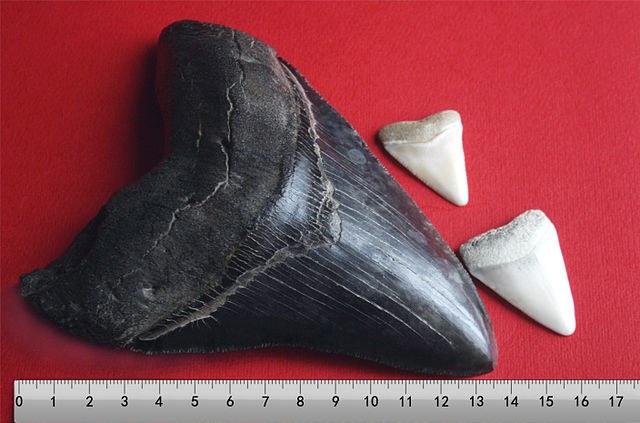The evidence—reported in the journal Palaeogeography, Palaeoclimatology, Palaeoecology—consists of fossilized bones from animals that megalodon devoured. Riddled with the enormous shark's bite marks, the fossils are the first to show exactly what species the megalodon consumed in its diet.
All of the fossils were unearthed at a site called Aguada de Lomas in southern Peru.
Lead author Alberto Collareta of the University of Pisa and his team analyzed the fossils and determined that megalodon, which could grow to over 53 feet long, ate the now-extinct baleen whale Piscobalaena nana and the early seal Piscophoca pacifica. Both animals were still impressive in size, at just under 16.5 feet long, but were presumably easy, nutritious pickings for megalodon.
"What else would you eat but a large marine mammal?" Christina Slager, director of animal care and exhibits for San Francisco's Aquarium of the Bay, told Seeker when told of the new findings.
She said that great white sharks today like to eat seals and sea lions, but will usually only scavenge on whales. Except for the pygmy right whale, all other baleen (filter-feeding) whales today greatly surpass even the biggest great white sharks in size.
Kenshu Shimada, a professor of paleobiology at DePaul University, explained to Seeker that whales have likely become bigger than sharks "due to the evolution of their migration behavior where large body sizes must have helped them to travel long distances and exploit food sources not only along the coasts but also in the middle of the ocean."
He added, "Whether megalodon migrated long distances can only be speculated at the present time."
Uncertainty also exists concerning how megalodon interacted with its whale prey. Collareta and his colleagues admit that "it is virtually impossible to discriminate between active predation and scavenging when dealing with fossil specimens," yet they believe it is possible megalodon actively hunted small-sized whales.
In fact, one of the fossils is a whale skull that the shark bit directly into, going right after the head meat. This and the other bite marks unmistakably were made by megalodon, according to the researchers. One tooth mark alone, they say, measured over 2 inches long.
 |
| Megalodon tooth next to great white shark teeth. |
Slager said that the traditional explanation for the giant shark's disappearance has been climate change.
"Based on its remains, megalodon preferred warmer waters," she said. "The Ice Age began when this species went extinct, but other factors in addition to climate change could explain why the shark died out."
Collareta and his team note that various lineages of small baleen whales experienced population crashes just before megalodon's disappearance. Slager agreed that this is likely not just a coincidence, and that lack of food could have contributed to the iconic shark species' demise.
Shimada explained, "Most sharks are opportunistic generalists capable of feeding on variety of organisms, but some forms with specialized diets, such as plankton, may be particularly prone to extinction if a major shift in global oceanic conditions takes place." He added that this was the probable fate of a group of plankton-eating bony fishes, called suspension-feeding pachycormids, which bit the dust at the end of the Dinosaur Era about 65 million years ago, when global populations of plankton collapsed.
Shimada said the jury is still out, however, on what precise factors did in megalodon.
The disappearance of both the early small baleen whales and megalodon could reveal "a process of co-extinction of prey and predator," Collareta and his team believe.
Read more at Discovery News

No comments:
Post a Comment